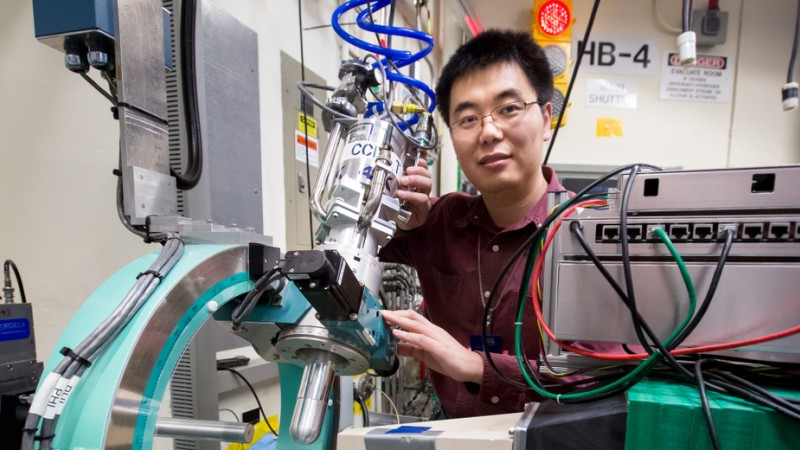Jie Ma, a professor from Shanghai Jiao Tong University in China, is using neutrons at Oak Ridge National Laboratory’s High Flux Isotope Reactor to discover a three-dimensional image of the magnetic lattice of an oxide material (Ba2CoTeO6) containing quantum properties that could provide new insight into how electron “spins” can improve data processing and storage in computers.
For his experiment, Ma is using HFIR’s Four-Circle Diffractometer, beam line HB-3A. He hopes to better understand quantum spin, a unique property that causes materials to mimic magnetic characteristics, even if the particle does not carry a charge.
“Scientists have been searching for quantum spin liquids in low dimensional systems, such as the magnetic 2-D honeycomb lattice ruthenium trichloride recently reported by ORNL and our work on a 2-D triangular lattice. But, not many of such systems are ideally 2-D, without interactions between the 2-D layers,” Ma said. “We hope the new image revealed in this experiment will give us a more detailed explanation for why quantum spins behave the way they do.”
Ma’s research focuses on the magnetic interactions between the material’s layers rather than the individual interactions on each layer because they often appear to perturb the quantum spins in each layer and are essential to understanding how to realize real quantum spin liquids.
In a previous experiment, Ma used powder samples to characterize the material’s structure. Interestingly, when he studied the material in a single crystal sample at HB-3A, the instrument revealed a different lattice structure, leading him to question if the new results indicated a difference in the route to quantum spin states.
“The interesting thing is that the lattice structure is different between the powder and single-crystal samples,” Ma said. “We think if the lattice is a little bit different here, then the magnetic structure might also be different for the material.
“Because we are interested in the magnetic properties of a material with quantum spins, neutrons are the best technique to study the magnetic structure or the magnetic dynamics of this material,” he added. “Furthermore, HFIR is the highest power research reactor in the world, and the neutron instruments here are really perfect for what we want to do.”
Ultimately, an in-depth analysis of quantum spin is necessary if researchers want to apply a new understanding of such properties to advancements in quantum computers, Ma explained.
“If we understand the magnetic properties that are exerted onto materials like these and how they move in that space, then we can translate those properties into everyday technology.”
HFIR is a Department of Energy Office of Science User Facility. UT-Battelle manages ORNL for the DOE’s Office of Science. The Office of Science is the single largest supporter of basic research in the physical sciences in the United States, and is working to address some of the most pressing challenges of our time. For more information, please visit http://science.energy.gov/.



